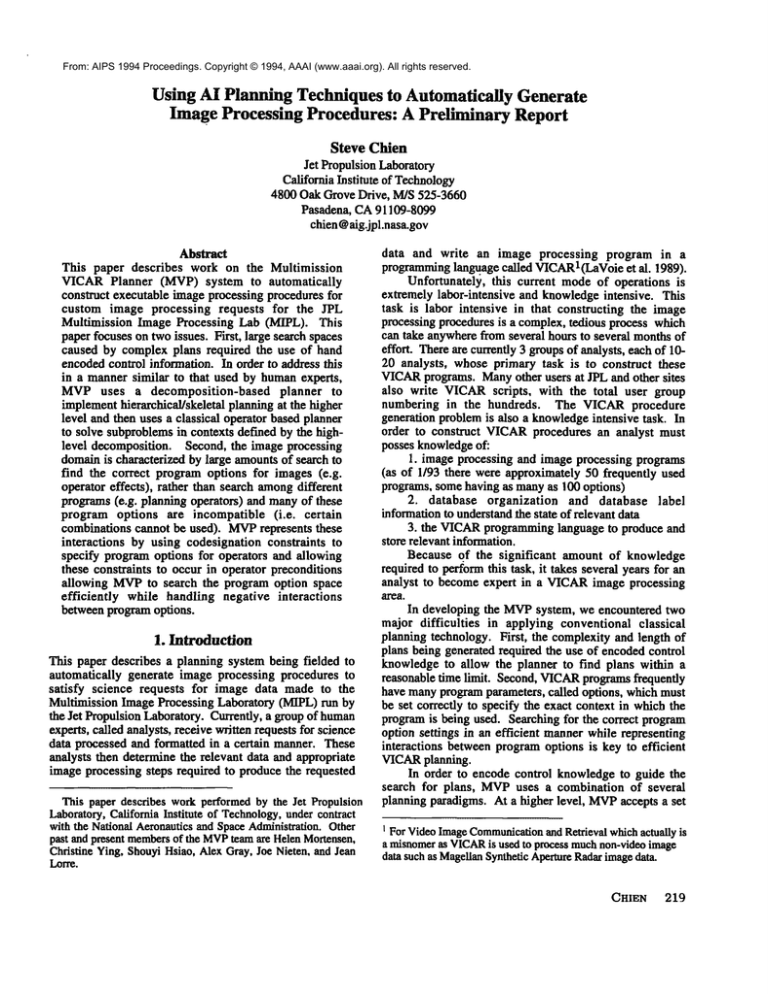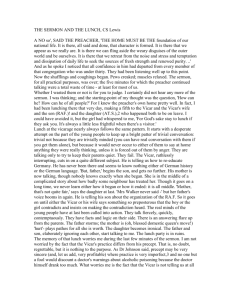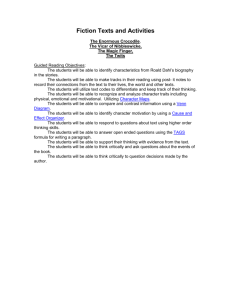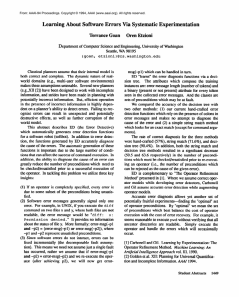
From: AIPS 1994 Proceedings. Copyright © 1994, AAAI (www.aaai.org). All rights reserved.
Using AI Planning Techniques to Automatically Generate
Image Processing Procedures: A Preliminary Report
Steve Chien
Jet Propulsion Laboratory
California Institute of Technology
4800 Oak Grove Drive, M/S 525-3660
Pasadena, CA91109-8099
chien @aig.jpl.nasa.gov
Abstract
This paper describes work on the Multimission
VICARPlanner (MVP) system to automatically
construct executable image processing procedures for
custom image processing requests for the JPL
Multimission Image Processing Lab (MIPL). This
paper focuses on two issues. First, large search spaces
caused by complex plans required the use of hand
encodedcontrol information. In order to address this
in a manner similar to that used by humanexperts,
MVPuses a decomposition-based
planner to
implementhierarchical/skeletal planning at the higher
level and then uses a classical operator based planner
to solve subproblemsin contexts defined by the highlevel decomposition. Second, the image processing
domainis characterized by large amountsof search to
find the correct program options for images (e.g.
operator effects), rather than search amongdifferent
programs (e.g. planning operators) and manyof these
program options are incompatible (i.e. certain
combinations cannot be used). MVPrepresents these
interactions by using codesignation constraints to
specify program options for operators and allowing
these constraints to occur in operator preconditions
allowing MVPto search the program option space
efficiently while handling negative interactions
between program options.
1. Introduction
This paper describes a planning system being fielded to
automatically generate image processing procedures to
satisfy science requests for image data made to the
Multimission Image Processing Laboratory (MIPL) run
the Jet Propulsion Laboratory. Currently, a group of human
experts, called analysts, receive written requests for science
data processed and formatted in a certain manner. These
analysts then determine the relevant data and appropriate
image processing steps required to produce the requested
This paper describes work performedby the Jet Propulsion
Laboratory,California Institute of Technology,undercontract
with the National Aeronauticsand SpaceAdministration. Other
past and present members
of the MVP
team are HelenMortensan,
Christine Ying, ShouyiHsiao, Alex Gray, Joe Nieten, and Jean
Lorre.
data and write an image processing program in a
l(LaVoie et al. 1989).
programminglanguage called VICAR
Unfortunately, this current modeof operations is
extremely labor-intensive and knowledgeintensive. This
task is labor intensive in that constructing the image
processing procedures is a complex, tedious process which
can take anywherefrom several hours to several monthsof
effort. There are currently 3 groups of analysts, each of 1020 analysts, whose primary task is to construct these
VICAR
programs. Manyother users at JPL and other sites
also write VICARscripts, with the total user group
numbering in the hundreds. The VICAR procedure
generation problem is also a knowledgeintensive task. In
order to construct VICARprocedures an analyst must
posses knowledgeof:
1. image processing and image processing programs
(as of 1/93 there were approximately 50 frequently used
programs, somehaving as manyas ! 00 options)
2. database organization
and database label
informationto understandthe state of relevant data
3. the VICARprogramminglanguage to produce and
stere relevant information.
Because of the significant
amount of knowledge
required to performthis task, it takes several years for an
analyst to become expert in a VICARimage processing
area.
In developing the MVPsystem, we encountered two
major difficulties
in applying conventional classical
planning technology. First, the complexity and length of
plans being generated required the use of encoded control
knowledge to allow the planner to find plans within a
reasonable time limit. Second, VICAR
programs frequently
have manyprogramparameters, called options, which must
be set correctly to specify the exact context in which the
programis being used. Searching for the correct program
option settings in an efficient mannerwhile representing
interactions between program options is key to efficient
VICARplanning.
In order to encode control knowledge to guide the
search for plans, MVPuses a combination of several
planning paradigms. At a higher level, MVPaccepts a set
I For VideoImageCommunication
and Retrieval whichactually is
a misnomeras VICAR
is used to process muchnon-videoimage
data such as MagellanSyntheticApertureRadarimagedata.
CHIEN
219
From: AIPS 1994 Proceedings. Copyright © 1994, AAAI (www.aaai.org). All rights reserved.
of imageprocessing goals and uses skeletal and hierarchical
planning techniques to classify it into one of a set of
problem classes, such as movie-frame color triplet
processing, or mosaicking with absolute navigation. This
problemclassification then allows the individual processing
goals to be assigned into different subproblemsbased upon
the overall context of the image processing task (i.e.
problem class, project/spacecraft, presence or absence of
other goals, etc.). This process ends whenthe planner is
able (after search) to reduce all of the high level goals into
goals achievable by the operator-based planner (Pemberthy
& Weld 1992). Each of these subproblems is then solved
by the operator-based planner. The resulting set of plan
operators is then converted to an executable PDFby a code
generation module which uses macro expansion to perform
syntactic modifications to producethe desired output.
The VICARdomain also has the characteristic
of
search amongprogramoptions (operator effects) to achieve
goals. For example, one type of correction is a rotational
perspective correction which corrects for the planetary
rotation when combiningseveral images taken at different
times into a single image. In order to perform this
correction,
the VICARprogram PTP must know the
position of the camera (e.g., spacecraft) relative to the
planet center. This information can be specified (derived)
using any one of several sources: through navigation predict
information (e.g. spacecraft navigation information), own
created navigation information (e.g., information derived by
analyzing the edge of the planet in the image), ownsupplied
spacecraft pointing information (e.g. previously navigating
and then processing the image). Additionally, each of these
navigation methodshas further choices and options, (e.g.
the owncreated navigation information requires that you
specify the navigation source used, which maybe one of 8
source methods). The VICARlanguage uses program
options to specify to the programshowthis information is
specified.
Each set of program options typically
corresponds to a set of preconditions which will allow the
operator to achieve some effects. Unfortunately, these
program options often have negative interactions - i.e.,
certain combinations of programoptions are incompatible.
Because of the number and complexity of these program
options and their interactions, frequently MVP
is searching
to find a consistent set of program options (whose
preconditions can be satisfied) rather than to find an
operator whosepreconditions can be satisfied.
In order to deal with this search among program
options MVPspecifies program options as codesignation
constraints on variables occurring in planning operators.
These codesignations then appear in preconditions of
effects and thusly positive and negative interactions
between program options can be directly represented and
reasoned about using least commitmentstrategies. This
means that MVPneed not commit to program option
settings unnecessarily - when determining the correct
setting for one option, it need not constrain other unrelated
options. This also meansthat whenenforcing protections,
MVPcan enforce that incompatible options not be used by
220
POSTERS
enforcing negative codesignations to prevent preconditions
of the possibly interfering effect.
The remainder of this paper is organized as follows.
Section 2 describes the VICAR
image processing domainin
greater detail and describes the overall operations context
and architecture of the MVPsystem. Section 3 describes
how MVPintegrates decomposition-based and operatorbased planning and how this allows MVPto operate in a
manner more understandable to the analysts. Section 4
describes how the representation
of VICARprogram
options as codesignations
and codesignations
in
preconditions allows MVPto efficiently reason about
VICAR
program options. Section 5 reports on the current
status
of the MVP system and describes
some
characteristics of the domain(s) implemented. Section
describes current and future work an summarizes the
principle contributions of this paper.
2.
VICAR Image
Processing
and MVP
VICAR is a general-purpose
image processing
programming language designed to promote the
development and re-use of general-purpose
image
processing algorithms for MIPL needs. The primary
function of VICAR
is to allow individual image processing
steps (called VICARprograms) to be combined into more
complex image processing scripts called procedure
definition files (PDFs). MIPLanalysts construct PDFs
perform image correction, image enhancement, construct
mosaics, and to create movies and render objects.
Individual processing programs perform functions such as
photometric correction (correcting the image for lighting
conditions due to the position of the sun relative to he
cameraand target), radiometric correction (correcting for
varying cameraresponse dependingon where in the field of
view the image is read), and line fillin (replacing missing
lines cause by data transmission errors by interpolation).
VICARimage processing maps naturally onto the AI
planning problemwhere: 1) the initial state corresponds to
the initial database state (the state of relevant imagefiles,
the existence of appropriate calibration files, etc.); 2)
planning operators correspond to VICAR
programs: and 3)
the problemgoals correspond to the image processing goals
(desired image characteristics and format, etc.). The
VICARimage processing domain represents a rich AI
planning domainwith tens of relevant database label fields
relevant to processing,
approximately 100 VICAR
programs(as of I/93), manyof which have tens of program
options which control the image processing effects of the
program, with manysubareas of VICAR
image processing,
with diverse sets of problemgoals, (tens per subarea).
Due to the diversity of VICAR
image processing, we
are currently targeting
the VOYAGER
and GALILEO
mosaicking and color triplet processing areas of image
processing. This allows us to focus on a subset of the
relevant database fields, VICAR
programsand options, and
problem goals. This particular
target area tracks
approximately 50 image file attributes,
30 VICAR
programs, and 20 image processing goals. Weestimate that
From: AIPS 1994 Proceedings. Copyright © 1994, AAAI (www.aaai.org). All rights reserved.
there are on the order of tens of these VICAR
processing
subdomainsand are currently evaluating several follow-on
application areas.
The overall architecture for the MVPsystem is shown
in Figure I. The user inputs a problem specification
consisting of processing goals and certain image
information using a menu-basedgraphical user interface.
These goals and problem context are then passed to the
decomposition-based planner which uses skeletal and
hierarchical planning methodsto classify the problem type
and use this classification to decomposethe problem into
smaller subproblems. During this decomposition process,
MVPdetermines which information on the database state is
needed by the planner to solve the subproblems.
lmage~~ocessing
Information ~ iV Goals
De~.tn~Pse~fi~_ as~mbly constraint~
..........
l
Ii Interface~
! Opora
r-I__ IPI ’G, I______
basea [plan
n.ie~e~tabl~
[_.____.~ info.
t’laaner
[segment..........~PDF
Figure l: MVPArchitecture
These subproblems are then solved by a conventional
operator-based planner using the subproblem goals and
initial states as indicated by the problem decomposition.
The resulting plan segments are then assembled using
constraints derived in the decomposition process. The
resulting plan is then used to generate an actual executable
VICAR PDF using conventional
macro-expansion
techniques.
3. Integrating
Decomposition-based
Operator-based
Planning
and
Plans in the MVPdomaincan be of considerable length (up
to 100 steps) and each step (or VICARprogram)
involve reasoning about numerous complex effects (many
operators have tens of effects). Due to the large search
space caused by this complexity, conventional operatorbased planning approaches are not able to tractably
construct plans in the VICAR
domain without significant
control knowledge.
Additionally, even if a purely operator-based planning
approach were able to generate plans to solve the VICAR
problems, these plans wouldbe difficult for MIPLanalysts
to understand. Typically, analysts begin by classifying the
general problembeing addressed into one of a general class
of problems, such as mosaicking, color triple processing,
etc. They then use this classification and the problem
context to decomposethe plan into several abstract steps,
such as local correction, navigation, registration, touch-ups,
etc. A planning system which mimickedthis approach to
producing VICARPDFswould be desirable.
Skeletal and Hierarchical
Planning in MVP
Skeletal planning (Iwasaki & Friedland 1985) is
approach to planning which casts planning as a structured
classification problem. In skeletal planning, a planner
identifies a new problem as one of a general class of
problems based upon the goals and initial state. This
technique was originally
developed as a model of
experiment design in molecular biology; however, skeletal
planning is also an accurate modelof howexpert analysts
attack VICARprocedure generation problems. Typically,
in a VICAR
problem,there is a central goal for processing,
such as mosaicking, which then dictates a decompositionof
the overall problem into subproblems such as local
correction, navigation, and registration. MVPattacks a
VICAR
problem by first determining the general problem
class, and then using this problemclass to performan initial
decompositionof the top--level imageprocessing goals.
Hierarchical planning (Stefik 1981) is an approach
planning where abstract goals or procedures are
incrementally refined into more and more specific goals or
procedures
as dictated
by goal or procedure
decompositions. MVPuses this approach of hierarchical
decompositionto refine the initial skeletal plan into a more
specific plan specialized based on the specific current goals
and situation.
This allows the overall problem
decomposition to be influenced by factors such as the
presence or absenceof certain imagecalibration files or the
type of instrument and spacecraft used to record the image.
For example, geometric correction uses a model of the
target object to correct for variable distance from the
instrument
to the target.
For VOYAGER
images,
geometric correction is performed as part of the local
correction process, as geometric distortion is significant
enough to require immediate correction before other image
processing steps can be performed. However, for
GALILEO
images, geometric correction is postponed until
the registration step, where it can be performed more
efficiently.
Decomposition-based
Planning in MVP
MVPuses a decomposition-based approach (Lansky 1992)
to perform Skeletal and Hierarchical planning. In a
decomposition-basedapproach, decomposition rules dictate
how in plan-space planning, one plan can be legally
transformed into another plan. The planner then searches
the space plans defined by these decompositions.
Decomposition-basedapproaches are extremely powerful in
that manyother paradigms (such as modal truth criterion
planning (Lansky 1992) can be implemented in
decomposition-based
approach. Syntactically,
a
decompositionrule is of the form:
CHIEN
221
From: AIPS 1994 Proceedings. Copyright © 1994, AAAI (www.aaai.org). All rights reserved.
LHS
G] = initial goal set/actions
RHS
GR = reduced goal
set/actions
Co = constraints
==> Ct = constraints
N = notes on decomposition
C2 = context
This rule states that a set of goals or actions GI can be
reduced to a new set of goals or actions GRif the set of
constraints Co is satisfied in the current plan and the context
C2 is satisfied in the current plan provided the additional
constraints Ci are addedto the plan.
Skeletal planning in MVPis implemented in by
encoding decompositionrules whichallow for classification
and initial decompositionof a set of goals correspondingto
a VICAR problem class.
The LHS of a skeletal
decomposition rule in MVPcorresponds to a set of
conditions specifying a problem class, and the RHS
specifies an initial problemdecompositionfor that problem
class. For example, the following rule represents a
decomposition for the problem class mosaicking with
absolute navigation.
LHS
Gl= mosaicking goal present
Co= null
C2=an initial classification
has not yet been made
RHS
GR = 1. local correction,
2. navigation
3. registration
4. mosaicking
5. touch-ups
C I = these subtasks be
performed in order
1.2.3.4. 5.
protect local correction
until mosaicking
N = the problemclass is
mosaicking
This simplified decompositionrule states that if mosaicking
is a goal of the problem and an initial
problem
decomposition has not yet been made, then the initial
problem decomposition should be into the subproblems
local correction, navigation, etc. and that these steps must
be performed in a certain order. This decomposition also
specifies that the local correction goals must be protected
during the navigation and registration processes.
In general, MVP
permits goals and abstract steps to be
specified in the GI &GRfields. The constraints CO & C I
may be ordering and codcsignation constraints and the
context mayspecify the presence or absence of attributes
over the plan or goals (such as a certain goal not being
present, etc.).
Hierarchical planning is also implementedwithin the
decompositionframework. In this case the LHSspecifies a
context in which a set of goals or actions can be
decomposedinto a lower level set of goals or actions. For
example, the decomposition rule below states that if the
limb is present in all of the images (meaningthat the sunfacing edgeof the planet is visible in all of the images), for
VOYAGER
and GALILEO
images, the navigation step can
222 POSTERS
be performed by absolute navigation (a process in which
each of the images can be navigated independently).
LHS
RHS
Gt= navigation action present
Ga = I. absolute
navigation
Co=null
C2= the project is VOYAGER Ci = null
or GALILEO
N = null
and limbs are present in all images
This decomposition-based approach to skeletal and
hierarchical planning in MVPhas several strengths. First,
the decompositionrules very naturally represent the manner
in which the analysts attack the procedure generation
problem. Thus, it was a relatively straightforward process
to get the analysts to articulate and accept classification and
decomposition rules for the subareas which we have
implemented thus far, Second, the notes from the
decompositionrules used to decomposethe problem earl be
used to annotate the resulting PDF to make the VICAR
programs more understandable to the analysts. Third,
relatively few problemdecompositionrules are easily able
to cover a wide range of problems and decompose them
into muchsmaller subproblems.
In the current version of MVP,there are on the order
of 10 skeletal decomposition rules and 30 hierarchical
decomposition rules which cover on the order of hundreds
of goal combinations and problem contexts. These
decomposition rules are able to break downscript into
typically 5 goal sets each of approximately5 to 10 goals,
where each goal set is typically achievable by a subplan of
10 operators or less. This size of subplanis easily handled
by the operator-based planner with search of on the order ol
thousands of plans and can be constructed on the order of
l 0s of secondsfor a SparestationI 0.
4. Program Options in VICARand MVP
One interesting aspect of the VICARdomain is that the
majority of the search to achieve goals and to enforce
protections is not at the programselection level (which
corresponds to operator selection in the planning process)
but rather at the programoption level (whichcorrespondsto
the operator effect planning level). Thus, whenplanning to
achieve a goal, MVPsearches more in determining how to
set program options to achieve a goal (e.g. how to set
variable constraints to satisfy preconditions) rather than in
determining which VICARprogram (planning operator)
use to achieve the goal. This presents a problem for
efficiently reasoning about interacting program options
(operator effects) in that certain combinationsof program
options (operator effects) are inconsistent (i.e., cannot
used together). Searching these combinations of operators
effects efficiently whenthe operator effects do not interact,
yet correctly restricting to those legal combinationsis novel
to the MVPplanner.
Due to this difficulty
of search among VICAR
program options. MVPuses an operator-based planning
component which extends conventional operator-based
From: AIPS 1994 Proceedings. Copyright © 1994, AAAI (www.aaai.org). All rights reserved.
planning (Pemberthy & Wold 1992). MVPrepresents
VICARprogram options as variable codesignation
constraints.
Thus, if a VICARprogram has a program
option which allows for several ways to specify spacecraft
pointing information for a particular imageprocessing step,
MVP would represent
these different
methods as
conditional effects of a single planning operator, with the
appropriate preconditions
(including
variable
codesignations). If certain program options (operator
effects) are inconsistent, they would be represented by
having preconditions with conflicting codesignation
constraints. Whenusing an operator effect to achieve a
subgoal in the plan, MVPfirst checks to see if the
codesignation preconditions are consistent with the plan,
only then allowing the effect to be used (and adding the
codesignation constraints to the plan).
For example, one VICAR program is the PTP
program, which allows for multiple images taken at similar
times to be corrected to appear as if they were taken at the
same time. This programneeds to knowthe position of the
spacecraft relative to the target of the image(typically the
planet center). This information can be specified in one of
several different ways, such as using the spacecraft
navigation information, specific VICARprograms which
attempt to compute this information from the imago (the
usual method), or by specifying the exact pixel location
knownfrom previous operations in the PDF. Typically, an
analyst will include VICAR
code to derive this information
directly from the image. In this case the exact programand
options being used to compute this information are
frequently needed by the PTP program. For example, for
the VOYAGER
project, if one wishes to use pointing
information previously derived using the FARENC
program, it wouldbe stored in a navigation data structure
called SEDR.The conditional effect might look something
like the following (codesignation constraints are markedby
an asterisk *).
IF
(SEDRSRC
is specified to be FARENC)*
and
(PC and RPCare not specified)*
the project of file is VOYAGER1
or VOYAGER2
and
appropriate SEDR
data files fertile exist and
the camera numberRCAM
for thefile has been correctly
specified and
the FDSfertile has been correctly specified
THEN
then output image ou~le will be registered to the
reference image as specified
This method for representing VICARprogram options is
important in that it allows for independentprogramoptions
to be reasoned about and constrained independently yet
represents the interaction betweeninteracting options.
For example, the PTPprogramoption to translate the
image during the PTP step, requires that the camera
pointing specification be directly specified using the planet
center (PC) and reference planet center options (RPC),
whichspecify a particular point in the imagedirectly as the
planet center. These options are incompatible with the
FARENC
source of camera pointing information. MVP
represents this constraints by negative codesignations
appearing in the preconditions of these incompatible
options (the *-ed codesignationconstraints listed above).
However, non-interacting
options such as PTP
options to resize the image or to include or delete the
backgroundof the imageare not affected. These options do
not interact with the specification of pointing information
and thusly can be reasoned about independently.
In contrast,
most planners do not allow for
codesignation constraints on operator effects, and thusly
wouldhave to place contradictory preconditions to enforce
disallowed combinations or break inconsistent operator
effects into different planning operators - representing
consistent combinations of operator effects. Detecting
inconsistent preconditions when choosing an effect is
analogous to our codesignation method. Not detecting
these contradictory preconditions whenchoosing an effect
would cause considerable unnecessary search. Breaking
inconsistent effects (program options) into separate
operators requires an increase in the numberof operators
exponential in the numberof inconsistent options (N pairs
of incompatible options requires 2N operators). Even
worse, when selecting an operator which one option
decided, the planner would have to arbitrarily committo
decisions on other programoptions - potentially causing
unnecessary search. As the numberof programoptions can
be quite large (frequently in the tens of options and
sometimes as manyas 100 options), these are important
representational and search efficiency issues.
5. Status of MVP
MVPversion 1.0, was demonstrated in June 1993 and
addressed the subproblem of mosaicking with absolute
navigation for VOYAGER
images. This system handled
approximately 10 goals, involving approximately 15
VICARprograms, and tracked about 20 file features. In
December 1993, MVPversion 1.1 was demonstrated and
had additional capabilities allowing addressing GALILEO
color triplet processing and mosaicking as well as some
simple filtering steps. Version 1.1 handles approximately
20 goals, 30 VICARprograms, and models approximately
50 file attributes (Chien &Mortensen,1993).
MVPversion 1.0 and 1.1 were implemented in Lucid
CommonLISP, and run under the Openlook windowing
environment. MVPversion 2.0, which has roughly
equivalent domaincoverage to version 1.1 is implemented
in C, and run in the Motif windowing environment (the
MIPLstandard) and will be operational in April 1994.
The current coverage for MVPis already at the useful
level. Over a test suite of 5 typical mosaickingand color
reconstruction tasks, an expert analyst estimated that MVP
wouldreduce effort to generate an initial PDFfor an expert
analyst from 1/2 a day to 15 minutes and that it would
reduce the effort for a novice analyst from several days to 1
CHIEN
223
From: AIPS 1994 Proceedings. Copyright © 1994, AAAI (www.aaai.org). All rights reserved.
hour. For one particularly challenging PDF, the expert
analyst estimated the complete start-to-finish task took
approximately 3 days effort, and that with MVPthe task
wouldhave taken less than half that time.
6. Discussion and Conclusions
There are a number of outstanding research issues which
prevent straightforward application of MVP
to certain other
VICAR
tasks. In this section we discuss several of these
areas of current and future work. One important issue is
that of representing plan quality. Frequently in the VICAR
domain, there are multiple ways of achieving processing
goals, but the quality of the final resulting imagewill vary
depending upon which approach is used. For example,
when constructing a mosaic using relative navigation (a
process of matching adjacent frames by finding common
points), the order in whichone places the tiles together will
significantly affect final image quality. In other cases,
performingthe correction steps in different orders, although
possible, will result in varying image quality. Currently,
these preferences are represented by using decompositions
and false preconditions, but more general declarative
methods for representing this information would be
preferable because of added ease of maintenance.
Another area of work is that of automatically
recognizing and handling simple loops. Frequently a set of
images are processed in an identical or almost identical
fashion. The current MVPimplementation is able to handle
a number of these cases in the decomposition phase,
howevera more general approach wouldbe to recognize the
commongoal structure and re-use the plan found for the
first imagere-instantiated for the other images. Currently
MVPwill generate plans which contain the loops expanded
out. While recognizing the loops would improve the speed
of plan generation, the more significant advantage is that
MVPcould produce more readable plans containing the
loops. Webelieve that straightforward EBLtechniques
applied to constraint-posting planning techniques (Chien
1990) wouldallow for this capability.
Anadditional area for work is creating a development
environment to allow for maintaining and extending domain
knowledge expressed in MVP.This would involve tools
for tracing and debugging similar to those currently
available for rule-based systems. Such tools would allow
analysts to easily assess the effects of modifyingoperator
definitions to reflect program changes and to debug and
refine operator definitions whenencoding new application
domains. Another useful capability would be explanation
facilities for the planner. Frequently an analyst wants to
knowif another operator ordering is consistent with the
current plan structure (dependencies) or why operator
was used in the plan (in particular, whywasn’t a different
operator Y used?). Developing an environment to support
these capabilities (particularly to analyze other possible
plan structures) is an area of future work.
One major area of current work is extending the
current MVPsystem to other application areas. Weare
currently examining earth imaging applications and
224
POSTERS
atmospheric science applications
of VICARimage
processingas potential future application areas.
In summary,this paper has described an ar plication of
classical planning techniques to automatic generation of
image processing procedures. In using classical AI
planning techniques for VICARimage processing, two
difficulties
were encountered. First, the length and
complexity of VICAR
procedures necessitated encoding of
control knowledgeto allow for tractable solution of real
VICARproblems. In order to solve these problems in a
manner understandable by human analysts, MVPfirst
decomposesthe problems, attacking them in a skeletal
planning and hierarchical planning methodology. The
resulting subproblems are then solved by a conventional
operator-based planner. The second difficulty encountered
is that in the VICAR
application domain, frequently MVP
must perform significant search amongprogramoptions (in
contrast to typical planning applications wherethe search is
amongplanning operators). To address this problem, MVP
represents VICARprogram options as codesignation
constraints on variables and allows codcsignation
constraints to appear in operator preconditions. As a result,
MVP
can reason efficiently about programoptions in a least
commitmentfashion. Finally, we described the current
status of the MVPplanner and outlines several areas of
current and future work.
REFERENCES
(Chien 1990) S. Chien, ’*An Explanation-based
Learning Approach to Incremental Planning," Technical
Report UIUCDCS-R-90-1646, Department of Computer
Science, University of Illinois, November
1990.
(Chien & Mortensen, 1993) S. Chien and
Mortensen, "MVP Domain Specification
Document,
Version !.0 - Mosaicking with Absolute Navigation and
Color Triplet Processing," Internal JPL Publication, Jet
Propulsion Laboratory, California Institute of Technology,
Pasadena, CA, 1989.
(Iwasaki & Friedland, 1985) Y. Iwasaki and
Friedland, "The Concept and Implementation of Skeletal
Plans," AutomatedReasoningI, 1 (1985), pp. 161-208.
(Lansky 1993) A. Lansky, "Localized Planning With
Diversified Plan Construction Methods," Technical Report
FIA-93-17, NASAAmesResearch Center, June 1993.
(LaVoieet al. 1989) S. LaVoie, D. Alexander, C. Avis,
H. Mortensen, C. Stanley, and L. Wainio, VICARUser’s
Guide, Version 2, JPL Publication D-4186, Jet Propulsion
Laboratory, California Institute of Technology, Pasadena,
CA, 1989.
(Pembenhy& Weld, 1992) J. S. Pemberthy and D.
Weld, "UCPOP:A Sound Complete, Partial Order Planner
for ADL," Proceedings of the Third International
Conference on KnowledgeRepresentation and Reasoning,
October 1992.
(Stefik, 1981) M. Stefik, "Planning with Constraints
(MOLGEN:
Part I )," Arti ficial Intelligence 16,2(I 981),
I 1 !-140.








